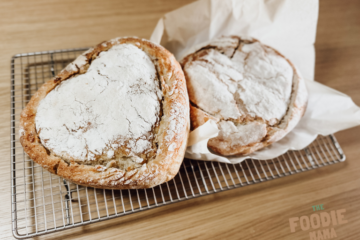With Australia Day coming up soon, I thought it would be fitting to write about one of Australia’s iconic cakes – the lamington! It’s so iconic, it made its way to Malta where you’ll find it in a pink or red coating rather than the traditional chocolate coating. It is known by a few names in Malta; pasti mill-ħomor, pasti mir-roża and bambaluni. They became popular in Malta in the 60s and 70s and can still find them in kiosks and pastry shops on the Islands. These were my nanna’s favourite sweet and would bring home to her 10 kids on the rare occasion when she went to Rabat city in Gozo.
There is some controversy about the lamington’s origins. Some say that the sponge landed in chocolate icing by accident, being the fault of a clumsy maid. Another attributes the invention to Lady Lamington, a cooking instructor at Brisbane’s Central College. But it’s likely origin is that it was named after Baron Lamington, the Governor of Queensland from 1895 to 1901 where his French chef, Armand Galland created it on a whim as a way to use up stale sponge.
As for how the lamington made its’ way to Malta, one could say that they were brought over to Malta by returned migrants from Australia. Whatever the story, I love that the Maltese adopted the lamington and made it their own. You could say il-pasta mir-roża is a Maltese-Australian cake, as Maltese-Australian and sweet like me! Paying tribute to my birth country and to my country by blood, I share with you the way my mum makes these fluffy little cakes.
Pink Lamingtons – Pasti mir-Roża
You will need a 20cm cake pan. This recipe will make 20-25 small cakes, depending how big you cut them.
Ingredients:
- 1 packet strawberry jelly
- 250g butter
- 200g castor sugar
- 4 eggs
- 200 ml milk
- 350g self-raising flour
- 2 tsp vanilla extract
- 1/2 tsp salt
- desiccated coconut
Method:
- Preheat the oven to 180C. Prepare the jelly according to the packet instructions. Place in the fridge for about 1 and a half hours, or until slightly thickened (consistency should be like an unbeaten egg white).
- Line your cake pan with baking paper and set aside.
- With an electric beater or mixer, add the butter and sugar until creamy, then add the eggs and combine.
- Slowly add the flour to the mix until well combined.
- Lastly, add the vanilla, pour in the milk and mix in carefully – do not over mix.
- Pour the cake mixture into your tin and place into the oven for 15-20 minutes.
- Let stand in the tin for a few minutes, then remove from the cake pan onto a cooling rack. Allow to cool completely before applying the coating.
- Cut the cake into smaller cake size pieces.
- Spread the desiccated coconut out on a plate and dip each cake in the jelly mixture, letting it soak in slightly then roll in the coconut to coat.
- Refrigerate for at least an hour to allow to set before eating.
Tips:

Photo by Charmaine Tokic
- Don’t overmix the cake batter after adding the flour. This can toughen the texture and remove the air from the cake, making it too dense and not light and fluffy how you would usually find a lamington.
- I find freezing the cake a little to firm it up makes it easier to handle when applying the jelly mixture and coating with coconut.
- Trimming the edges of the cake will allow all the sides to absorb the jelly mixture evenly and also allows for the pink colour to really stand out.
- Don’t soak in the jelly mixture too much and ensure you coat all sides of the cake.
- You could be a little fancy and add fillings like whipped cream and/or jam.
- Made too many to finish? Use the leftover cakes to make an epic trifle!
If you would like to read about a particular foodie topic feel free to drop me a line via editor@thevoiceofthemaltese.org or direct message me on my Instagram @_thefoodiemama



